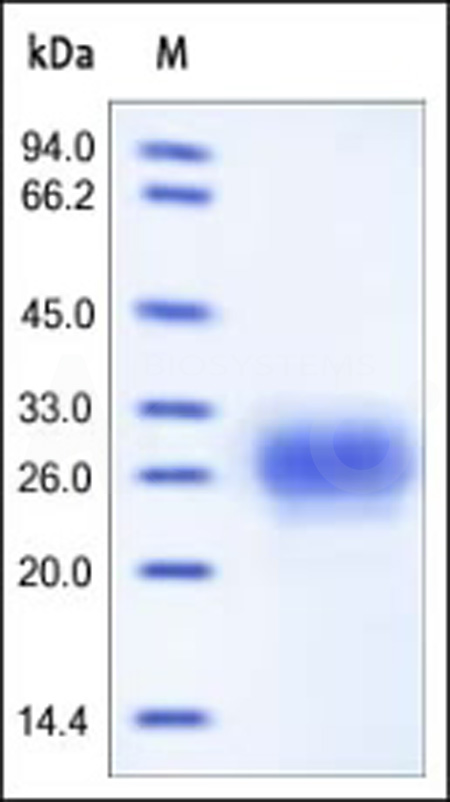分子别名(Synonym)
TFPI2,PP5,REF1
表达区间及表达系统(Source)
Human TFPI-2, His Tag (TF2-H5227) is expressed from human 293 cells (HEK293). It contains AA Asp 23 - Lys 213 (Accession # NP_006519.1).
Predicted N-terminus: Asp 23
Request for sequence
蛋白结构(Molecular Characterization)

This protein carries a polyhistidine tag at the C-terminus.
The protein has a calculated MW of 22.7 kDa. The protein migrates as 26-32 kDa under reducing (R) condition (SDS-PAGE) due to glycosylation.
内毒素(Endotoxin)
Less than 1.0 EU per μg by the LAL method.
纯度(Purity)
>95% as determined by SDS-PAGE.
制剂(Formulation)
Lyophilized from 0.22 μm filtered solution in PBS, pH7.4. Normally trehalose is added as protectant before lyophilization.
Contact us for customized product form or formulation.
重构方法(Reconstitution)
Please see Certificate of Analysis for specific instructions.
For best performance, we strongly recommend you to follow the reconstitution protocol provided in the CoA.
存储(Storage)
For long term storage, the product should be stored at lyophilized state at -20°C or lower.
Please avoid repeated freeze-thaw cycles.
This product is stable after storage at:
- -20°C to -70°C for 12 months in lyophilized state;
- -70°C for 3 months under sterile conditions after reconstitution.
质量管理控制体系(QMS)
电泳(SDS-PAGE)

Human TFPI-2, His Tag on SDS-PAGE under reducing (R) condition. The gel was stained with Coomassie Blue. The purity of the protein is greater than 95%.
背景(Background)
Tissue Factor Pathway Inhibitor 2 (TFPI2) is also known as placental protein 5 (PP5) and retinal pigment epithelial cell factor 1 (REF1), is a member of the Kunitz-type serine proteinase inhibitor family, is a structural homologue of tissue factor pathway inhibitor (TFPI). TFPI2 is highly abundant in the full-term placenta and widely expressed in umbilical vein endothelial cells, liver, placenta, heart, pancreas, and maternal serum at advanced pregnancy. TFPI2 may play a role in the regulation of plasmin-mediated matrix remodeling. Inhibits trypsin, plasmin, factor VIIa/tissue factor and weakly factor Xa and has no effect on thrombin. Reduced synthesis of TFPI-2 has been related to numerous pathophysiological processes such as inflammation, angiogenesis, atherosclerosis, retinal degeneration and tumor growth / metastasis.























































 膜杰作
膜杰作 Star Staining
Star Staining












 Loading ...
Loading ...




